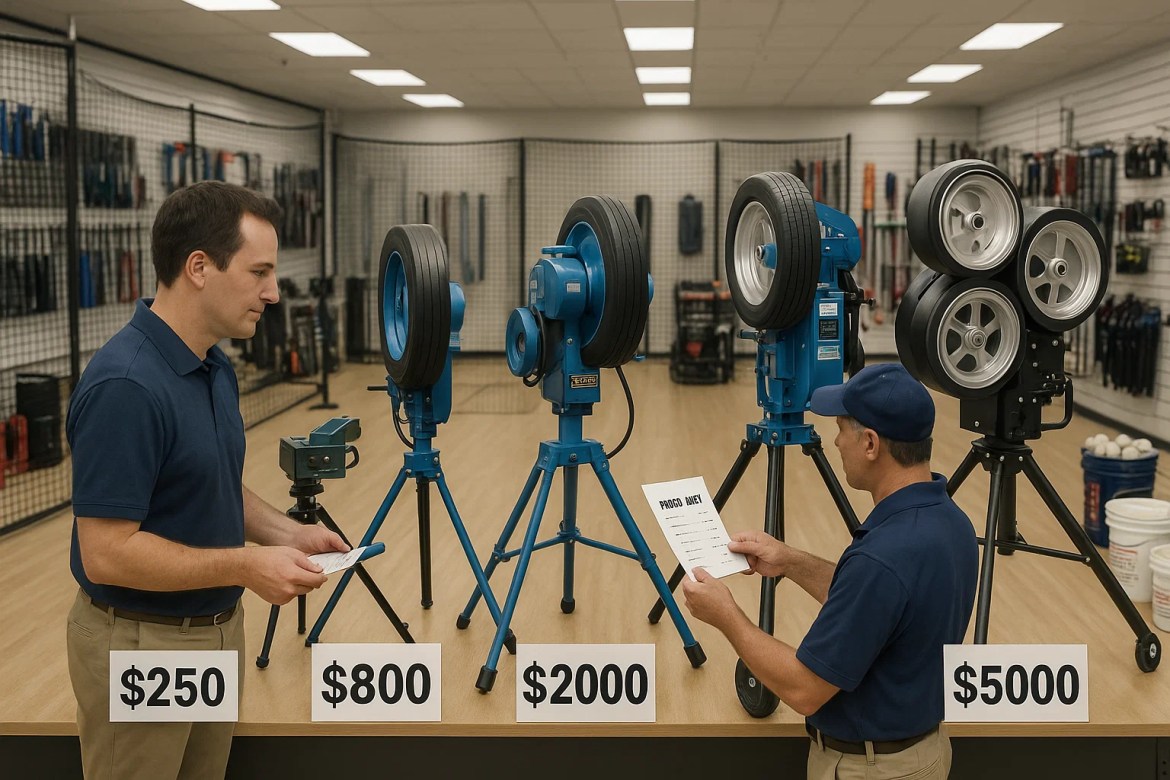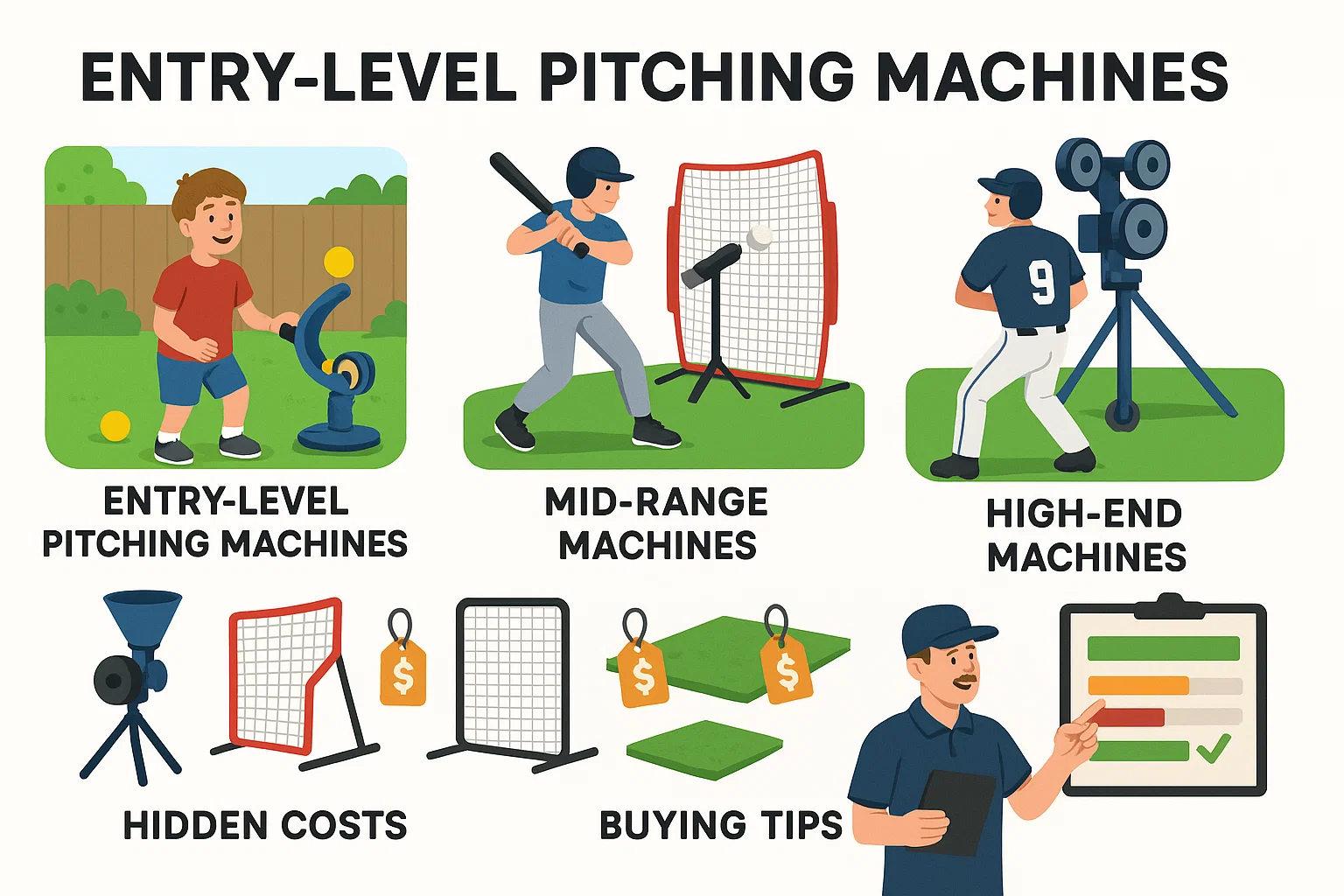Think it’s just a machine with a price tag? Think again. We’re breaking down the real cost of hitting practice at home — and it’s more than you think.
Baseball Dreams Start with Swings
For families, coaches, and aspiring athletes, a pitching machine often feels like the natural next step. But the moment you type “how much is a pitching machine” or “how much are pitching machines” into Google, you’re hit with a flood of prices — ranging from $150 to $5000 — and not a lot of clarity.
So, what’s the real deal?
This guide dives deep into the costs, from upfront pricing to hidden add-ons, so you can invest wisely without any surprises.
Why All Pitching Machines Aren’t the Same
Let’s get one thing straight: not every pitching machine serves the same purpose.
Some are built for kids just learning the game.
Others are designed for elite athletes and pros.
And many sit somewhere in the middle — which is why the prices vary so much.
That’s why instead of simply asking “how much is a pitching machine,” the better question is: “Which type of machine fits my needs?”
Entry-Level Machines ($100–$300)
Entry-level pitching machines are ideal for:
Kids aged 5–9
Families focused on fun rather than formal training
Casual backyard use
These machines often:
Use mechanical arms or springs
Throw foam or plastic balls
Offer very limited speed and pitch options
💡 Perfect if you’re introducing baseball in a relaxed, beginner-friendly way.
However, don’t expect realism or longevity. Most Little League players outgrow them quickly.
Mid-Range Machines ($400–$1000)
This range is popular among youth coaches and serious teens. Why? Because these machines balance price and performance quite well.
Here’s what you usually get:
Variable pitch speeds (30–60 MPH)
Electric-powered motors (1-wheel or 2-wheel)
Adjustable pitch angles
Compatibility with real or dimpled balls
Optional remote feeds
💡 Ideal for regular practice at home or on the field. These machines grow with your player.
Additionally, they’re portable, durable, and strike a nice balance between fun and functionality.

High-End Machines ($1200–$3000+)
If you’re coaching a school team, managing a facility, or training a future college player, this is where you should look.
Here’s what sets them apart:
Dual or triple-wheel systems
Pitch speeds reaching up to 100 MPH
Advanced pitch types like sliders, splitters, and curveballs
Programmable sequences for randomization
Built-in automatic ball feeders
Bluetooth or digital control interfaces
💡 Serious machines for serious athletes — the kind that elevate performance to the next level.
You get real value for the price, especially if you train multiple times per week.
Pro-Level Machines ($3500–$6000+)
These commercial-grade machines are used in MLB academies and top-tier sports facilities. They’re built for:
Daily high-volume usage
Game-mode simulation
Ultimate accuracy and timing
Features include:
Touchscreen programming
Game-like throwing motions
Industrial-grade design
Advanced safety features
💡 Not your average backyard machine. These are built for those who live and breathe baseball.
Unless you’re running a full-time training operation, this level might be overkill — but for some, it’s the perfect fit.
The Hidden Costs You Didn’t Budget For
The machine’s price is just one part of the story. Several extras add to your final bill — and many buyers don’t plan for them.
⚙️ Essential Accessories
Ball feeder: $200–$600
Protective screen: $100–$500
Battery pack (for outdoor use): ~$300
Stands or carts for mobility
🏠 Setup Add-Ons
Backyard cage or netting: $200–$1500
Turf or mats: $100–$300
Shipping or assembly services
🔧 Ongoing Maintenance
Replacement wheels/motors
Regular alignment and tuning
Replacing damaged balls
💡 A $900 machine can easily lead to a $1500 total cost once everything is in place.
What About Used Machines?
Buying used can save 30–50%, but make sure you inspect the following:
Is there an active warranty?
Are key parts like feeders or plugs included?
Can you still order spare parts?
Does it meet your player’s current needs?
💡 Avoid discontinued models with no support — you’ll spend more fixing than saving.

Match Price to Player Skill
Still unsure how much you need to spend? Match the player’s age and goals to a machine type:
Beginner (5–8 years): $100–$300 → Mechanical or foam ball machines
Youth (9–12 years): $400–$800 → 1-wheel electric
Teen Athlete: $800–$1500 → 2-wheel machines with feeders
Advanced Player: $1500–$3000+ → Programmable or 3-wheel units
Facility Use / Coach: $2500–$6000 → Pro-grade commercial machines
Final Thoughts: Buy Once, Buy Smart
So… how much is a pitching machine?
It really depends on who you’re buying it for, how often it will be used, and what kind of training you want.
Instead of focusing only on price, focus on purpose. Match your budget to your player’s level and future goals.
Here’s a quick takeaway:
✅ Start small if you’re new to the sport
✅ Plan your accessories and space setup ahead
✅ Spend wisely if you’re in it long-term
And above all?
Make sure your investment encourages passion for the game — not frustration.






